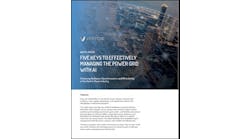When most people consider a microgrid, they think of on site generation serving a single business or an enclosed campus. But another concept is emerging called multi-user microgrids, which allows neighbors to share distributed energy resources to receive reliable electricity.
Only a few such multi-user microgrids exist. But some electricity experts say that conditions could evolve and benefits mount for more of them.
Richard Stuebi, president of Future Energy Advisors, sees improving microgrid economics and increasing customer need for resilience as a growing catalyst.
By jamesteohart/Shuttersstock.com
“Even today, certain sets of customers find the benefits offered by multi-user microgrids to outweigh the additional costs,” writes Stuebi in a recent study on the subject.
That study was authored by a research team from the Institute of Sustainable Energy at Boston University.
Expounding on what a multi-user microgrid is, Stuebi says that it provides multiple energy consumers the ability to self-supply electricity during grid outages. Durinng normal periods, they they leverage the existing power grid. For this movement to become a trend, the economics would have to improve, including that of solar-plus-storage, which bottles electrons when the sun is out to discharge them for later use.
Some examples of multi-user microgrids include Commonwealth Edison’s Bronzeville microgrid, which is under development; the Philadelphia Navy Yard and Burrstone Energy Center (Utica, NY), both in operation; and National Grid’s Potsdam Community Microgrid, a New York project in planning.
The Institute of Sustainable Energy studied the northeastern United States to discover the barriers to development of multi-user microgrids. It found:
- Inability to monetize resilience (and other value streams)
- Conflicts with pre-existing rights associated with electricity delivery
- Preferential rights for utilities to cross public rights-of-way
- Ambiguity about viable multi-user microgrid ownership models
- Utility assertion of rights via legal action
- Lack of suitable risk-mitigation structure
- Insufficient leadership to coalesce solutions
And at least some of those obstacles can be overcome by tailoring business models to meet situation-specific cases, phasing in development to minimize cost and strengthening regulations to improve the odds of multi-user microgrids.
“If the barriers that prevent the development of multi-user microgrids can be reduced or eliminated, a wide range of stakeholders (private individuals, utilities, businesses, etc.) stand to benefit from the internalization of various social surpluses that multi-user microgrids can produce,” says Stuebi.
The report also noted that more advocacy could help the microgrid industry overcome barriers.
“Although a growing number of conferences are being convened on the topic of microgrids, with the annual Microgrid Knowledge conference arguably being the best and most well-attended, the microgrid community generally lacks a focal point – such as a trade association – that is well-positioned to serve in convening, educational, research and advocacy capacities,” says the report. “No doubt, this reflects the fact that the microgrid market is still immature and consequently small, but there is a risk that the microgrid market will remain underdeveloped unless and until stakeholders organize for impact and provide necessary leadership for market participants.”
Track news about multi-user microgrids. Subscribe to the free Microgrid Knowledge newsletter.








